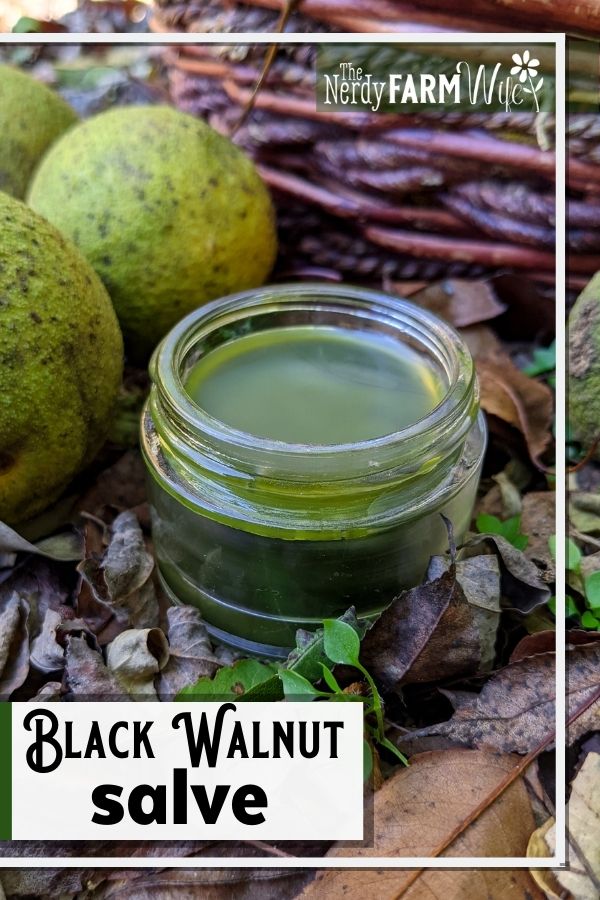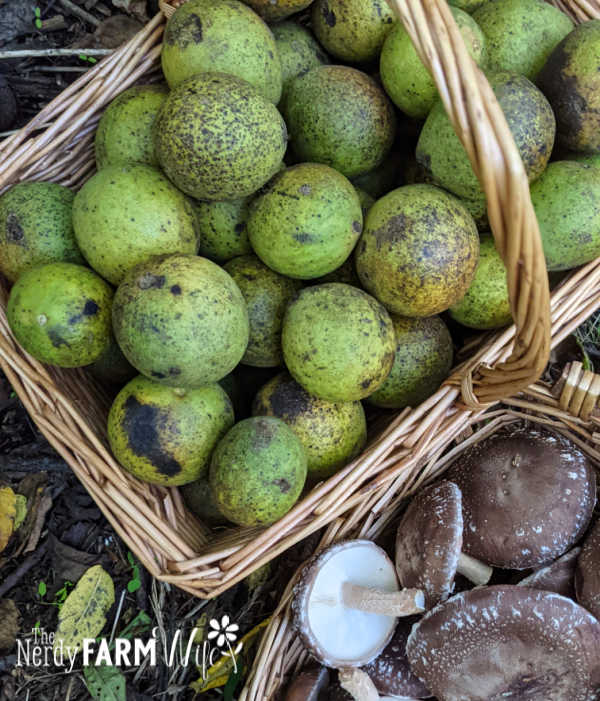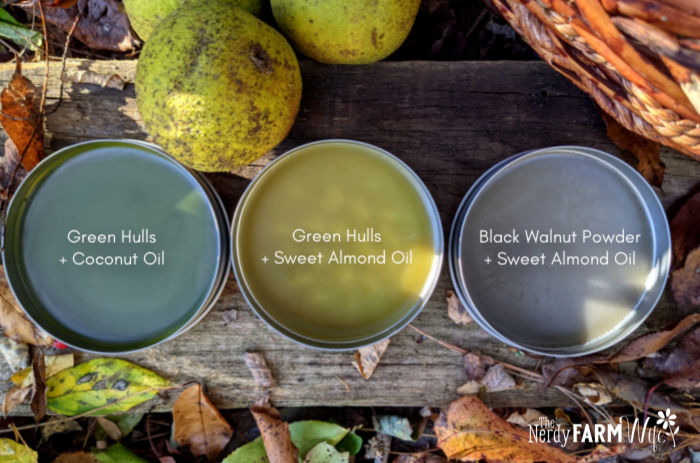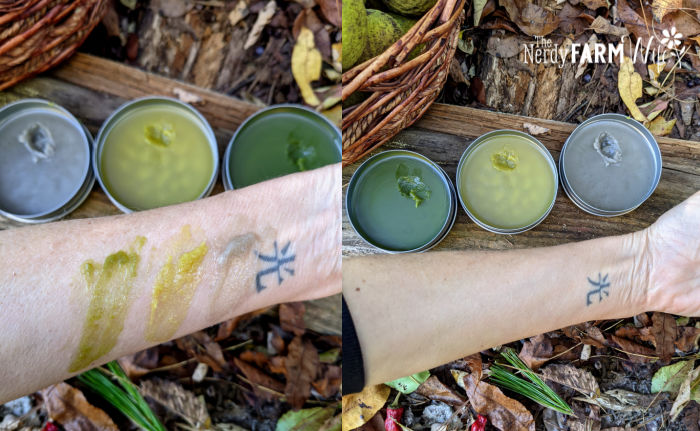Black Walnut Salve Recipe
Black walnut salve is useful for things like athletes foot, fungal rashes, toenail infections, ringworm, psoriasis, and various skin woes. If you have a longstanding mystery rash on your arm or leg and no one is quite sure what it is – try some black walnut salve and you may find relief!
To make this salve, you need to ideally source fresh black walnuts (Juglans nigra). There’s an abundance of them on the ground this time of year, to the point that some people find them a nuisance, so you may even be able to find a local friend, relative, or neighbor more than happy to share some from their yard.
If you can’t find any fresh, I’ve also given alternate directions using dried black walnut powder instead. The final color of the salve depends on if you use fresh or dry hulls, and what type of oil is used for the infusion, but all methods can be effective!
For more information on how to ID, harvest, and process black walnuts, plus more herbal uses besides salve, check out the article my daughter and I wrote for our family’s website:
A Note About Color Variations
Before you can make the salve, you must first make an infused oil.
If you use coconut oil + green hulls for the infusion, your salve will be a deep, almost blueish-green. (Coconut oil also makes a firmer salve in cold temperatures.)
If you use olive, sunflower, or other liquid oil + green hulls for the infusion, your salve will be more of a yellow-olive green.
If you use dried black walnut powder + any type of oil for the infusion, your salve will have a gray charcoal-like color.
Make the Infused Oil
To make an infused oil with fresh hulls:
- Break up pieces of fresh green hull newly harvested from black walnuts. (Wear gloves – this part stains your hands!)
- Fill a pint jar about half-way with the pieces of hull.
- Cover the hulls with your favorite oil or combination of oils, until the jar is almost full. Something light, such as apricot kernel, rice bran, or sweet almond oil soaks in nicely, or you may want the added anti-fungal benefits of coconut oil, or you can stick with classic olive oil.
- Place the uncovered jar down into a saucepan containing several inches of warm water.
- Place the pan on a medium-low burner and gently heat for about 2 to 3 hours.
- If the water starts simmering or bubbling, it’s too hot and the heat should be reduced.
- After 2 to 3 hours, remove from heat.
- You could use the oil right away, but I like to lightly cover it with cheesecloth or a scrap of old t-shirt held in place with a rubber band (to allow space for extra moisture to evaporate) and set it aside in a warm spot and let it infuse an additional 5 to 7 days for a stronger infusion.
- Strain and use the oil in salves or other skincare products.
- The finished oil will be a deep dark green or yellow-green, depending on oil type used, and will smell of black walnuts.
- Shelf life is around 9 months to 1 year if stored in a cool dark spot.
If you don’t have fresh black walnuts, try using 1 tbsp black walnut hull powder infused into 1 cup of oil, using the same method as above. Stir the oil several times as it infuses, to ensure that the powder doesn’t settle into one clump in the bottom of the jar.
Now that you’ve made the oil, you can use it as is, and rub on your skin as needed, but it’s a lot easier to use if you turn it into a salve.
Black Walnut Salve Recipe
There are several essential oil options to consider for this recipe, so I’ll share some suggestions below for you to choose from. When made with fresh hulls, the salve has a strong scent, so essential oils not only add extra benefits, but will help mellow the overall scent profile.
Yield: 4 ounces of salve
Ingredients
- 3.5 oz (100 g) infused oil, from above (abt 1/2 cup)
- 0.5 oz (14 g) beeswax pastilles (abt 2 loosely filled tbsp)
- 3 drops clove essential oil
- 18 drops lavender essential oil
- (Or see alternate essential oil ideas below)
Directions
- Combine the infused oil and beeswax into a heat proof jar or melting container.
- Set the jar into a pan containing several inches of water.
- Place the pan over a medium-low burner and allow the heat to gently melt the beeswax.
- Once melted, remove from heat.
- Stir in the essential oils of choice, then pour into containers.
- This batch will fill about 2 1/2 two-ounce tins, depending on how fully you fill the tins.
- Let cool and cover with the top/cap.
- Label and store in a cool dry spot. Shelf life is around 1+ year.
Essential Oil Choices for Your Salve
Here are a few essential oils to consider using in your salve – feel free to adapt to your personal needs! I personally like adding clove to this salve since it complements the scent and adds an extra antifungal punch, but it shouldn’t be used on kids under 10 or anyone with extra sensitive skin.
A 2% dilution rate for this 4 ounce recipe is 48 total drops of essential oil. (Keeping in mind for clove EO, don’t go over 0.6% – or for easier calculations, 0.5%. Three drops of clove is plenty in a salve this size.)
See my article: Essential Oil Dilution Chart & Skin Care Product Usage Rates, if you’d like to increase the amount of essential oil used.
| Essential Oil | Benefit, Notes |
| Clove Bud/Leaf (Syzygium aromaticum) | antifungal, antibacterial, helpful for infectious sores, athlete’s foot, numbs pain, has a warming, spicy scent, use sparingly, no more than 0.6% dilution rate, not for kids under 10 or extra sensitive skin |
| Lavender (Lavandula angustifolia) | gentle, calming, soothes inflammation, irritation, adds a pleasing herbaceous floral scent |
| Manuka (Leptospermum scoparium) | antiseptic, antifungal, used for ringworm, warts, scabies, athlete’s foot, bug bites, has a softer scent profile than tea tree |
| Myrrh (Commiphora myrrha) | reduces inflammation, helpful for boils, athlete’s foot, fungal-related itching, eczema, don’t use if pregnant or nursing |
| Tea Tree (Melaleuca alternifolia) | resinous antiseptic scent, strong antifungal, antimicrobial, may help psoriasis, ringworm, boils, acne, athlete’s foot, fungal infections, check with doctor before using if pregnant |
References & Further Reading
Plant Therapy Website. Essential Oils for Kids.
Purchon, Nerys and Lora Cantele. The Complete Aromatherapy & Essential Oils Handbook for Everyday Wellness.
Tisserand, Robert and Rodney Young. Essential Oil Safety, Second Edition.
Wormwood, Valerie Ann. The Complete Book of Essential Oils & Aromatherapy.







Thank you for this great article and recipe, Jan. My grandparents in CT used to have black walnut trees, so this brought me back to curing and cracking and picking the nuts with them. Imma see if I have any neighbors with walnuts on the ground I can glean and give this a try. I appreciate your clear directions. :)
Hi Beki, Those sound like wonderful memories! ? So happy you enjoyed the article & recipe!
Do you infuse all your herbs, flowers and hulls like that where you let them sit for a few days to further infuse or just with this one in particular?
Hi Tara! If I’m infusing the warm way, with a pot of water, then I do often like to let it sit an additional amount of time whenever possible, to make sure the oil is nice and strong. Sometimes if you’re in a hurry to make something you need sooner though, it’s okay to go ahead and use the amount you need, then retop the oil and let it infuse longer. The longer infusion time makes an extra nice oil though! :)
Glad to have another thing to do with black walnuts besides nocino! I don’t have a taste for the nuts, or the energy to break them open, but my late husband and I planted about 14 of them 20 years ago. So yay!
Hi Nadine, That is an abundance of black walnuts for sure! I’m so glad the salve recipe will be useful! ❤
Two questions –
1 I had sooo many green walnuts last month that I picked up and threw in ditch. I was able to rescue some but they are turning black already. Can they be used?
2. The beeswax – can I use actual beeswax from a hive? I know a local beekeeper that I get honey from. Or are the pastilles necessary?
Thanks so much!
Hi Cindy! Yes, you could you the blackening walnuts. I’ve read that past herbalists actually preferred the blackened ones, but over time, it became preferred to use the green ones. So my feeling is that both types would work! :)
Yes, you can use beeswax from the hive. Just grate the beeswax and use as normal. For that, I’d aim to use the weight measurement, since gratings have a different volume than standardized pastille size.
Hi, I bought a tincture of green walnut hull tincture that has been pre-mixed with grain alcohol at my local health food store. The only ingredients are grain alcohol and green walnut hulls. I found that it was burning my rash, due to the alcohol, and drying it out. I think its working, though. To help soothe the initial burn, I’ve been adding melted coconut oil, mixing it with the hull mixture, and dabbing it on my rash. Do you think this is ok to do or is the alcohol ingredient going to be too irritating?
Hi Samantha! As long as this has been making it feel better, it sounds like you found a solution that works for you!
You could also dilute the tincture with water to make it less burny, and use it as a wash, or apply it directly to the rash.
Also, some people find coconut oil makes their skin red and chapped, so if that happens, maybe try a non-coconut based remedy instead.
If you find it keeps irritating it, you might want to make a black walnut salve, or check with your local health food store – they might already have one available.
Hope your rash heals up quickly! ❤
Hi Jan,
I have a black walnut liquid herb treatment that per drop is equivalent to 25 mg and has organic alcohol and distilled water in it. Do you think that I would be able to add this to the oil instead of infusing the oil with black walnut husks? I don’t have any walnuts where I live.
Thank you, I love your recipes!
Hi Charmaine! The alcohol and oil won’t mix & the tincture will separate out if you add it directly.
I’ve experimented with combining black walnut tincture & coconut oil together and then heating it up over medium-low heat, in an attempt to evaporate the alcohol, and leave the walnut goodness behind.
It was kind of a splattery mess!
Your best best is to either dilute the tincture with water and directly apply it to spots you want the walnut to treat (keeping in mind the tincture tends to stain).
Or you could buy some dried black walnut powder & make your own salve, or if you check out Etsy – there’s quite a few ready made black walnut salves available on there too. :)
Good Morning, Jan. Do you prefer using walnuts picked off the ground or from the tree to make the salve? And what is your opinion about using the cut chunks of husks as opposed to grating the husk? Thank you. Blessings to you and yours this July 4th! Lynn
Hi Lynn! We use walnuts picked from the ground, though I have heard of some herbalists who like using the green walnuts from the tree.
Our walnut trees are all too tall for us to do that, so I’ve not tried it yet.
I use cut chunks of husk since that’s the easiest for me to get and use, but the smaller pieces should work well too. :)
If you gently strike the branch of the walnut tree with a long stick or pole, and if walnuts easily tumble down they are ripe enough for tincture and yet unblemished. Another way to determine if they are ripe enough is to gently squeeze an area of the outer husk. It will indent easily, meaning ripeness.
Cut the soft ripe husks in quarters and the quarter pieces just fall off the nut.
You can then cut them into smaller slices if you like and infuse oil with these in a clean glass jar. All the best!
Hi Jan! Beautiful article! As a beginner herbalist I have had several people come to me about what to use for yeast infections, or itchy areas in the female groin region. Would the black walnut salve be a safe thing to put on those sensitive parts of the body? If not, what do you recommend? Thank you so much!
Hi Mads, So happy you like the article! I would not use salve or oil based products.
One idea to use instead is a strong calendula tea applied externally.
Here’s an article on calendula tea:
https://thenerdyfarmwife.com/14-uses-for-calendula-tea/
Hello! Thank you for sharing this. I have a very important question though. I can’t seem to find an answer to.
What else can you do with the black walnut hulls after you infuse them and strain them out? Can I use them for body scrubs?
Thank you!
Sincerely,
Bernadeth Ryan
Hi Bernadeth,
That’s a great question!
I haven’t tried grinding black walnut shells at home before, because it’s my understanding that they can be really hard on your machinery.
It may be something that needs a strong commercial grinder.
If you do experiment with grinding the shells up at home, just watch your appliance carefully, that it doesn’t burn it out or damage it in some way.
It may work! I’m just not sure, since I haven’t personally tried it yet. If it does work, a scrub would probably be a very good way to use them! :)
Hi Jan
I infuzed the mixture in pint and quart jars and it’s time to strain and can it. Should I reheat it for the straining. It looks like it will be a bit difficult to strain it in solid form. Thanks in advance for your advice.
Hi Mark! Yes, you’re exactly right. If you use coconut oil or a fat that thickens at cooler temps/room temp, then you should heat the oil up to help it strain better.
hulls. .. what after the alcohol is strained could you then also do with the hulls ideas ? Thanks
Hi Cathy! I usually throw the hulls back out into the woods.
I’ve never tried grinding them, because I read that they are really hard on home grinders & I don’t want to break mine!
But if you have a really heavy duty grinder, they might could be turned into scrubs?? I’m not positive about that though, so don’t quote me on that! :)